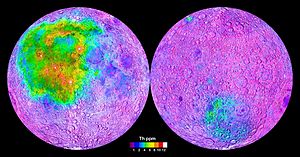KREEP
A type of lunar rock is called KREEP; this designation comes from its components: potassium (K), rare earths (REE, English: Rare-earth elements) and phosphorus (P).
The KREEP is currently believed to represent the last remnants of magma ocean crystallization that existed early in lunar geologic history. Large impacts excavated the lunar crust ejecting the bottom material mixing it with other debris forming KREEP breccias.
Indirectly, the origin of the KREEP is the result of the formation of the Moon, where the most accepted theory is that an object the size of Mars collided with the Earth about 4.5 billion years ago (see Big Impact Hypothesis). This impact put a large amount of material in orbit around the Earth that was ultimately added back together to form the Moon. Considering the large amount of energy released in this event, initially a large part of the Moon would have been molten, forming a nearly global magma ocean. When this ocean crystallized, minerals like olivine and pyroxene would have precipitated out and sank to form the lunar mantle. After crystallization had progressed by about three quarters, the anorthositic plagioclase would have begun to crystallize, and due to its low density, would have floated, forming an anorthosite crust. Elements called "incompatible" (ie those who prefer the liquid phase during magma crystallization) would have become more concentrated in it as crystallization progressed, forming a KREEP-rich magma, which would have been sandwiched between the crust and mantle.
Contenido relacionado
Wadati-Benioff zone
Epirogenesis
Struthiomimus altus
